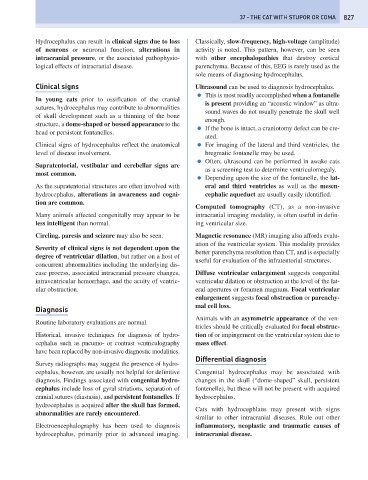Page 835 - Problem-Based Feline Medicine
P. 835
37 – THE CAT WITH STUPOR OR COMA 827
Hydrocephalus can result in clinical signs due to loss Classically, slow-frequency, high-voltage (amplitude)
of neurons or neuronal function, alterations in activity is noted. This pattern, however, can be seen
intracranial pressure, or the associated pathophysio- with other encephalopathies that destroy cortical
logical effects of intracranial disease. parenchyma. Because of this, EEG is rarely used as the
sole means of diagnosing hydrocephalus.
Clinical signs Ultrasound can be used to diagnosis hydrocephalus.
● This is most readily accomplished when a fontanelle
In young cats prior to ossification of the cranial
is present providing an “acoustic window” as ultra-
sutures, hydrocephalus may contribute to abnormalities
sound waves do not usually penetrate the skull well
of skull development such as a thinning of the bone
enough.
structure, a dome-shaped or bossed appearance to the
● If the bone is intact, a craniotomy defect can be cre-
head or persistent fontanelles.
ated.
Clinical signs of hydrocephalus reflect the anatomical ● For imaging of the lateral and third ventricles, the
level of disease involvement. bregmatic fontanelle may be used.
● Often, ultrasound can be performed in awake cats
Supratentorial, vestibular and cerebellar signs are
as a screening test to determine ventriculomegaly.
most common.
● Depending upon the size of the fontanelle, the lat-
As the supratentorial structures are often involved with eral and third ventricles as well as the mesen-
hydrocephalus, alterations in awareness and cogni- cephalic aqueduct are usually easily identified.
tion are common.
Computed tomography (CT), as a non-invasive
Many animals affected congenitally may appear to be intracranial imaging modality, is often useful in defin-
less intelligent than normal. ing ventricular size.
Circling, paresis and seizure may also be seen. Magnetic resonance (MR) imaging also affords evalu-
ation of the ventricular system. This modality provides
Severity of clinical signs is not dependent upon the
better parenchyma resolution than CT, and is especially
degree of ventricular dilation, but rather on a host of
useful for evaluation of the infratentorial structures.
concurrent abnormalities including the underlying dis-
ease process, associated intracranial pressure changes, Diffuse ventricular enlargement suggests congenital
intraventricular hemorrhage, and the acuity of ventric- ventricular dilation or obstruction at the level of the lat-
ular obstruction. eral apertures or foramen magnum. Focal ventricular
enlargement suggests focal obstruction or parenchy-
mal cell loss.
Diagnosis
Animals with an asymmetric appearance of the ven-
Routine laboratory evaluations are normal.
tricles should be critically evaluated for focal obstruc-
Historical, invasive techniques for diagnosis of hydro- tion of or impingement on the ventricular system due to
cephalus such as pneumo- or contrast ventriculography mass effect.
have been replaced by non-invasive diagnostic modalities.
Differential diagnosis
Survey radiographs may suggest the presence of hydro-
cephalus, however, are usually not helpful for definitive Congenital hydrocephalus may be associated with
diagnosis. Findings associated with congenital hydro- changes in the skull (“dome-shaped” skull, persistent
cephalus include loss of gyral striations, separation of fontenelle), but these will not be present with acquired
cranial sutures (diastasis), and persistent fontanelles. If hydrocephalus.
hydrocephalus is acquired after the skull has formed,
Cats with hydrocephlaus may present with signs
abnormalities are rarely encountered.
similar to other intracranial diseases. Rule out other
Electroencephalography has been used to diagnosis inflammatory, neoplastic and traumatic causes of
hydrocephalus, primarily prior to advanced imaging. intracranial disease.

